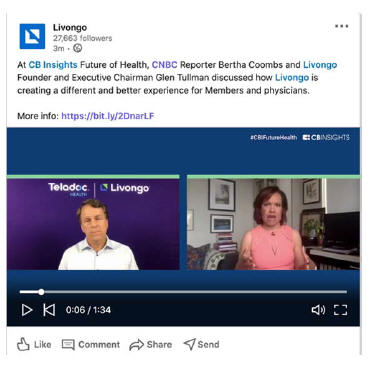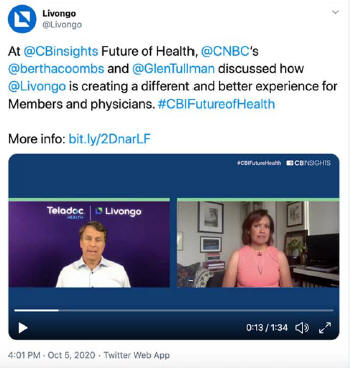- LVGO Dashboard
- Financials
- Filings
-
Holdings
-
Transcripts
- ETFs
- Insider
- Institutional
- Shorts
-
425 Filing
Livongo Health (LVGO) 425Business combination disclosure
Filed: 6 Oct 20, 12:00am
Filed by Livongo Health, Inc.
Pursuant to Rule 425 under the Securities Act of 1933,
as amended, and deemed filed pursuant to Rule 14a-6
under the Securities Exchange Act of 1934, as amended
Subject Company: Livongo Health, Inc.; Teladoc Health, Inc.
Commission File No.: 333-248568
The following communication was made available by Livongo Health, Inc. on LinkedIn on October 5, 2020.

Livongo 27,663 followers 3m ® At CB Insights Future of Health, CNBC Reporter Bertha Coombs and Livongo Founder and Executive Chairman Glen Tullman discussed how Livongo is creating a different and better experience for Members and physicians. More info: https://bit.ly/2DnarLF Like Comment Share Send
The following communication was made available by Livongo Health, Inc. on Twitter on October 5, 2020.

Livongo @Livongo At @CBinsights Future of Health, @CNBC’s @berthacoombs and @GlenTullman discussed how @Livongo is creating a different and better experience for Members and physicians. #CBIFutureofHealth More info: bit.ly/2DnarLF 4:01PM Oct 5, 2020 Twitter web App
CB Insights Future of Health Transcript
September 23, 2020
* * *
Bertha Coombs (00:00):
How do you work with doctors to make sure that you’re getting all of this data, but it’s manageable for them. And they’re not just getting a lot more work that’s just going to burn them out even more. Why?
Glen Tullman (00:12):
I think, I think again, it’s a big challenge and we’ve not done right by our physicians. And so many of them are so dedicated. So we see a future where we’ll be able to say that one, we’re going to keep them safe. No doctor wants a patient walking through the door and saying, I have coronavirus. That’s not safe for our doctors. We learned about that. So one to the extent that they can more efficiently deal with, with patients, with people who they see, one, we want to do that, we want to enable that too. We don’t want to give them more data. We want to give them better information, right? While I’m talking to you, if I can see the right information personalized to you on the screen, rather than sorting through an electronic health record or even paper-based files,
Bertha Coombs (01:00):
Basically give them the signal in the noise.
Glen Tullman (01:03):
Exactly. And that’s this whole idea of applied health signals. Perfect. Thank you. That’s what we want to do and use some data science to say, oh, and by the way, uh, remind Bertha about this and remind her about what’s upcoming and here’s her medications that will also be listed on the screen. It doesn’t look like she’s taking this. So all that will be on the screen and will make their lives easier so they can focus on the right people and with the right information, and that’s the goal.
Cautionary Note Regarding Forward-Looking Statements
This communication contains forward-looking statements within the meaning of the Private Securities Litigation Reform Act of 1995, Section 27A of the Securities Act of 1933, as amended, and Section 21E of the Securities Exchange Act of 1934, as amended. These forward-looking statements generally include statements regarding the potential transaction between Teladoc Health, Inc. (“Teladoc”) and Livongo Health, Inc. (“Livongo”), including any statements regarding the expected timetable for completing the potential transaction, the ability to complete the potential transaction, the expected benefits of the potential transaction (including anticipated synergies, projected financial information and future opportunities) and any other statements regarding Teladoc’s and Livongo’s future expectations, beliefs, plans, objectives, results of operations, financial condition and cash flows, or future events or performance. These statements are often, but not always, made through the use of words or phrases such as “anticipate,” “intend,” “plan,” “believe,” “project,” “estimate,” “expect,” “may,” “should,” “will” and similar expressions. All such forward-looking statements are based on current expectations of Teladoc’s and Livongo’s management and therefore involve estimates and assumptions that are subject to risks,
uncertainties and other factors that could cause actual results to differ materially from the results expressed in the statements. Key factors that could cause actual results to differ materially from those projected in the forward-looking statements include the ability to obtain the requisite Teladoc and Livongo stockholder approvals; uncertainties as to the timing to consummate the potential transaction; the risk that a condition to closing the potential transaction may not be satisfied; the risk that the anticipated U.S. federal income tax treatment of the transaction is not obtained; litigation relating to the potential transaction that have been or could be instituted against Teladoc, Livongo or their respective directors; the effects of disruption to Teladoc’s or Livongo’s respective businesses; restrictions during the pendency of the potential transaction that may impact Teladoc’s or Livongo’s ability to pursue certain business opportunities or strategic transactions; the effect of this communication on Teladoc’s or Livongo’s stock prices; transaction costs; Teladoc’s ability to achieve the benefits from the proposed transaction; Teladoc’s ability to effectively integrate acquired operations into its own operations; the ability of Teladoc or Livongo to retain and hire key personnel; unknown liabilities; and the diversion of management time on transaction-related issues. Other important factors that could cause actual results to differ materially from those in the forward-looking statements include the effects of industry, market, economic, political or regulatory conditions outside of Teladoc’s or Livongo’s control (including public health crises, such as pandemics and epidemics); changes in laws and regulations applicable to Teladoc’s business model; changes in market conditions and receptivity to Teladoc’s services and offerings; results of litigation; the loss of one or more key clients of Teladoc (including potential adverse reactions or changes to business relationships resulting from the announcement or completion of the potential transaction); changes to Teladoc’s abilities to recruit and retain qualified providers into its network; the impact of the COVID-19 pandemic on the parties’ business and general economic conditions; risks regarding Livongo’s ability to retain clients and sell additional solutions to new and existing clients; Livongo’s ability to attract and enroll new members; the growth and success of Livongo’s partners and reseller relationships; Livongo’s ability to estimate the size of its target market; uncertainty in the healthcare regulatory environment; and the factors set forth under the heading “Risk Factors” of Teladoc’s Annual Report and Livongo’s Annual Report, in each case on Form 10-K, and in subsequent filings with the U.S. Securities and Exchange Commission (the “SEC”). These risks, as well as other risks associated with the potential transaction, are more fully discussed in the joint proxy statement/prospectus filed with the SEC in connection with the proposed transaction. Other unpredictable or unknown factors not discussed in this communication could also have material adverse effects on forward-looking statements. Neither Teladoc nor Livongo assumes any obligation to update any forward-looking statements, except as required by law. Readers are cautioned not to place undue reliance on these forward-looking statements that speak only as of the date hereof.
No Offer or Solicitation
This communication does not constitute an offer to sell or the solicitation of an offer to buy any securities or a solicitation of any vote or approval, nor shall there be any sale of securities in any jurisdiction in which such offer, solicitation or sale would be unlawful prior to registration or qualification under the securities laws of any such jurisdiction. No offer of securities shall be made except by means of a prospectus meeting the requirements of Section 10 of the Securities Act of 1933, as amended.
Important Information for Investors and Stockholders
In connection with the potential transaction, Teladoc has filed a registration statement on Form S-4 (File No. 333-248568) with the SEC containing a prospectus of Teladoc that also constitutes a definitive joint proxy statement of each of Teladoc and Livongo. The registration statement, as amended, was declared effective by the SEC on September 15, 2020. Each of Teladoc and Livongo commenced mailing copies of the definitive joint proxy statement/prospectus to stockholders of Teladoc and Livongo, respectively, on or about September 15, 2020. Teladoc and Livongo may also file other documents with
the SEC regarding the potential transaction. This communication is not a substitute for the joint proxy statement/prospectus or registration statement or for any other document that Teladoc or Livongo have filed or may file with the SEC in connection with the potential transaction. INVESTORS AND SECURITY HOLDERS OF TELADOC AND LIVONGO ARE URGED TO READ THE JOINT PROXY STATEMENT/PROSPECTUS AND OTHER DOCUMENTS THAT ARE FILED OR WILL BE FILED WITH THE SEC, AS WELL AS ANY AMENDMENTS OR SUPPLEMENTS TO THESE DOCUMENTS, CAREFULLY AND IN THEIR ENTIRETY BECAUSE THEY CONTAIN IMPORTANT INFORMATION. Investors and security holders will be able to obtain free copies of the joint proxy statement/prospectus and other documents filed with the SEC by Teladoc or Livongo through the website maintained by the SEC at http://www.sec.gov. Copies of the documents filed with the SEC by Teladoc will be available free of charge on Teladoc’s website at https://ir.teladochealth.com and copies of the documents filed with the SEC by Livongo will be available free of charge on Livongo’s website at https://ir.livongo.com/. Additionally, copies may be obtained by contacting the investor relations departments of Teladoc or Livongo.
Teladoc and Livongo and certain of their respective directors, certain of their respective executive officers and other members of management and employees may be considered participants in the solicitation of proxies with respect to the potential transaction under the rules of the SEC. Information about the directors and executive officers of Teladoc is set forth in its proxy statement for its 2020 annual meeting of stockholders, which was filed with the SEC on April 14, 2020. Information about the directors and executive officers of Livongo is set forth in its Annual Report on Form 10-K for the year ended December 31, 2019, which was filed with the SEC on March 24, 2020, and its proxy statement for its 2020 annual meeting of stockholders, which was filed with the SEC on April 6, 2020. These documents can be obtained free of charge from the sources indicated above. Additional information regarding the interests of such participants in the solicitation of proxies in respect of the potential transaction are included in the registration statement and joint proxy statement/prospectus and other relevant materials filed with the SEC.
The term “Livongo” and such terms as “the company,” “the corporation,” “our,” “we,” “us” and “its” may refer to Livongo Health, Inc., one or more of its consolidated subsidiaries, or to all of them taken as a whole. All of these terms are used for convenience only and are not intended as a precise description of any of the separate companies, each of which manages its own affairs.